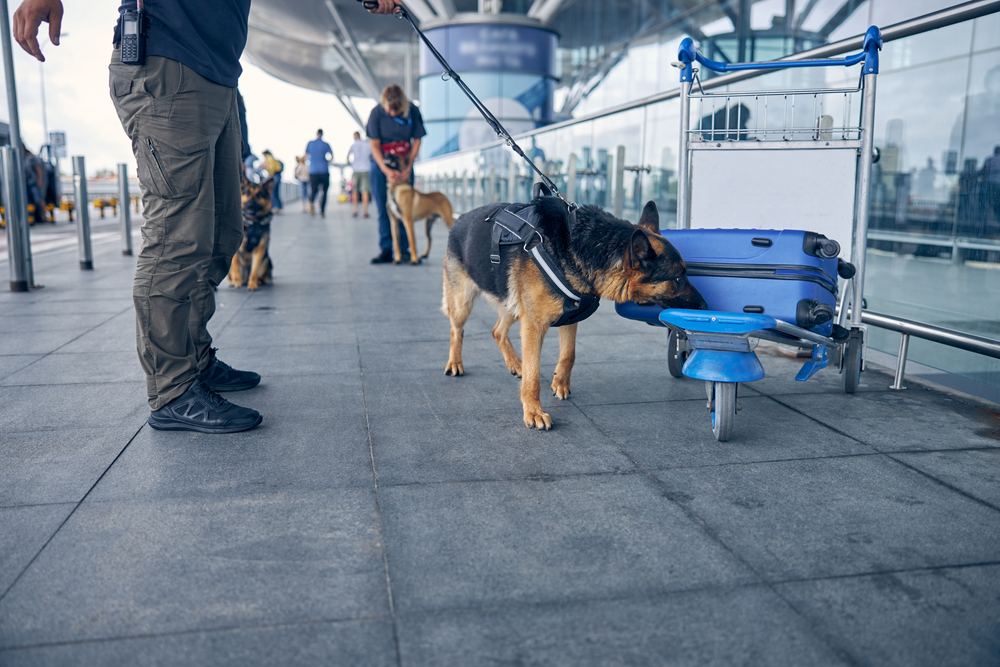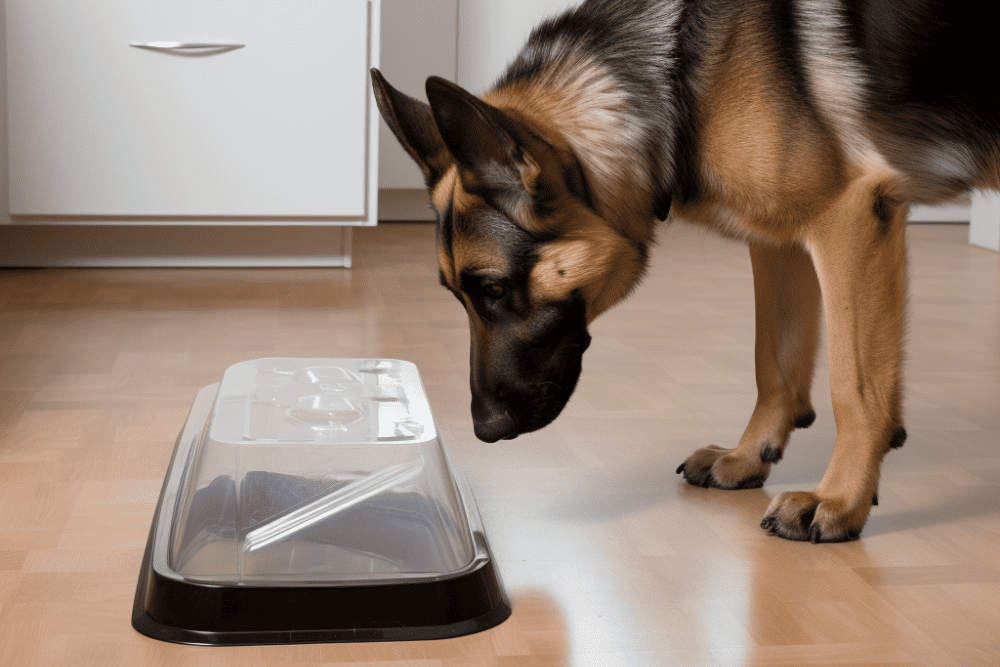Man’s best friend is well known for having impressive olfactory abilities. There are multiple stories of dogs sniffing out incredible things, from their owners’ cancers to Covid, to endangered species of animals.
You may have wondered whether drug dogs or sniffer dogs can identify illegal substances even when people seal them in airtight containers. Can that police dog at the airport detect illicit substances like marijuana if they are stored in a vacuum sealed bag?
What about your dog at home? If you store their dry dog food or dog treats in an airtight kitchen container, will they be able to sniff it out?
The short answer is no. Sniffer dogs and your dog at home have impressive abilities, but they can’t smell through materials like glass jars.
However, some airtight containers can leach scent through microscopic holes in the material. Dogs smell even tiny amounts of scent on the outside of containers.
So even if you have food (or other objects) stored in a glass jar with an airtight seal, your dog may be able to pick up on food particles that were inadvertently left on the outside of the container.
Let’s look at the science behind dogs' noses and how dogs can sometimes smell through “airtight” containers. We’ll also look at some ways that you can prevent your dog from using its incredible nose to sniff out its kibble and favorite treats.
A Deeper Look Into a Dog’s Incredible Sense of Smell
A dog can have up to 300 million olfactory receptors in its nose. In comparison, a human nose has about six million.
The part of a dog’s brain that processes smell inputs is about 40 times larger than the part of a human brain that does this.

Dogs Have an Amazing Sense of Smell When Compared to Humans
Dogs can detect substances at a strength of one part per trillion. That is the equivalent of smelling a single drop of blood in twenty Olympic swimming pools!
On top of that, a dog’s nose is specially structured to separate the functions of breathing and smelling.
That said, it is still not possible for a dog to “smell through” a solid surface. If a material contained no porous holes, a dog would not be able to smell what was on the other side.
Dogs can, however, smell through liquids.
Some dogs are specially trained to sniff out things underwater, for example, items dropped at the bottom of a lake or cadavers.
It usually takes special training for a dog to be able to do this, just as it takes special training for a dog to be able to detect drugs or other substances.
You may be asking yourself, “If a dog cannot smell through an airtight container, how does a drug sniffing dog detect drugs in sealed bags?”
Some drug smugglers indeed go to great lengths to hide their substances, even sealing them in what they think are smell-proof bags.

Criminals Will Have a Tough Time Sneaking Anything Past this Belgian Shepherd
Unfortunately for the drug smugglers, airtight doesn’t mean “smell proof.” Some airtight materials, such as plastic, contain microscopic pores that leak smell.
To a dog's nose, these microscopic holes are as large as the holes in a fishing net!
If a container was completely non-porous and airtight, it is unlikely that a dog would be able to smell through it.
Another reason that dogs pick up the scent of drugs even when they are in sealed containers is that they can pick up even trace amounts of a substance on the outside of the bag.
Remember: a dog can detect a drop of blood in twenty swimming pools.

Dogs Have a Finely Tuned Sense of Smell and Seem to Have Bottomless Appetites
Even if a person thoroughly washes their hands after handling a substance, they may still transfer trace amounts of the substance to the outside of objects -even a vacuum sealed containers when they touch it.
If someone seals a container while inside a room containing illegal substances, the container could pick up scents from the surrounding area. These scents could come from surfaces or even molecules in the air.
Drug dogs smell so well that they can detect a sealed bag of drugs at the bottom of a full 55-gallon barrel of gasoline. Put simply, there is no way to thwart a fully-trained drug-sniffing dog.
An airtight container is a container that has a lid that fits so snugly, no air can get in or out. Typically, the lid is made airtight by a rubber seal around the edge and a mechanism to close the lid extremely tightly.

She May Not Be Able to Smell What is Inside an Airtight Container, But She Can Smell Minute Food Particles on the Outside of the Container.
An airtight container could be made of glass, plastic, or something else. Usually, if you buy one for your kitchen, it will be made of glass or plastic.
If you buy an airtight container for your dog’s food, you should consider the container’s material before you buy it.
Just because a material is hard or doesn’t appear to have holes in it, does not mean it is not porous. Odor may still be able to escape.
The molecular structures of glass and plastic are very different. Glass is typically non-porous, meaning there are no holes on its surface, even microscopic ones.
The non-porous nature of glass is what makes it so smooth.
A good many plastics, on the other hand, are typically porous. They can absorb smells and even liquids. An airtight container made of plastic often contains microscopic holes that allow the scent to seep through.
While these smells are undetectable to humans, dogs can easily pick them up.
A plastic container with an airtight lid usually still contains enough microscopic holes to allow the scent to seep out, while a glass container does not. A dog cannot smell through an airtight container made of glass.
Does that mean that you should store your dog’s food in an airtight glass container? Not necessarily. Glass is not practical for storing dog food-it is more fragile and expensive than plastic.

Plastic Sealable Bins That Dogs Can't Get Into Are Appropriate for Food Storage
It is also hard to find airtight glass jars that are big enough to hold a lot of pet food.
So how should you store your dog’s food?
The best way to keep your dog out of its food is to put the food somewhere inaccessible. That could be a locked cupboard, up on a high shelf or in a locked pantry or basement.
Remember: you should always try to set your dog up for success by removing possible temptations from its environment.
The same goes for storing your food too. If you leave food in easily accessible places, you have no one to blame but yourself when your dog gets into those places.

Store Dog Food High Up in the Pantry Out of Reach of Your Dog
No matter how well-trained your dog is, it has certain instincts that are impossible to overcome. Do yourself a favor and keep all food out of reach.
Even if an airtight container is not smell-proof, it will keep your dog’s food fresher for longer. Freshness is particularly important if you like to buy your food in bulk.
Kibble goes stale within a few days if it is not put away in an airtight container. If stored properly, however, it can stay fresh for over a year.
If you have a safe, out-of-the-way spot where a glass container will not get knocked over and broken, or if you only need to store a small amount of food, then an airtight glass container like a mason jar might be a nice option.
Apart from being smell-proof, another benefit of glass is that it does not leak harmful chemicals. Some plastics, like BPA plastics, are known to leach chemicals into things that they come into contact with.
If you are worried about your dog’s food picking up chemicals from its container, opt for a glass container or look for a non-BPA plastic container.
There are lots of good options for dog food storage containers out there. Some plastic airtight tubs are stackable so you can easily store several types of food.
Other options include heavy-duty sealable dry bags that keep food fresh and pack down small.
The best dog food storage container is the one that fits your budget and your kitchen. If you do not have space for plastic tubs or don’t like how they look, consider glass or another material instead.
Dogs can pick up even the tiniest traces of scent. If you have been handling your dog’s food or a piece of meat, or something else very smelly and enticing to a dog, just washing your hands may not be enough to remove all the scent.
If you are concerned about contaminating your house, the best thing to do is to use gloves when handling smelly items. In addition to this, you should also wash your hands thoroughly.
Unless you are training your dog to do nose work or scent detection, you shouldn’t need to worry about getting smells around your house.
Your dog loves to use its nose! Having some enticing smells around can be a nice distraction or game.
If your dog exhibits worrying behavior like constantly sniffing or becoming obsessed with a certain smell or part of the house, the best thing to do is contact your vet.
This behavior could indicate that the dog is sick, or you may need to resolve the problem with special training or behavior modification.
